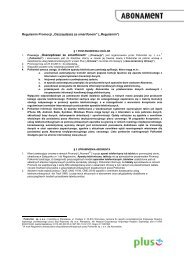Korytarz ekologiczny doliny Odry pdf
Korytarz ekologiczny doliny Odry pdf
Korytarz ekologiczny doliny Odry pdf
Create successful ePaper yourself
Turn your PDF publications into a flip-book with our unique Google optimized e-Paper software.
<strong>Korytarz</strong> <strong>ekologiczny</strong> <strong>doliny</strong> <strong>Odry</strong><br />
• ploughing of the large fragments of meadows and pastures in order to change their use<br />
(for growing cereals, vegetables);<br />
• burning of grass and local changes of trophic conditions;<br />
• significant drop of ground water levels caused by diminishing precipitation during the<br />
last decade, bottom erosion (especially between Brzeg Dolny and Œcinawa), earlier<br />
regulatory works, drainage, the less frequent inundation of the Oder terraces;<br />
• plans for the construction of new levees in Opole Province;<br />
• plans for filling old ox-bows, situated close to levees, because of the danger that during<br />
a flood water can be pressed underneath the levee;<br />
• highly developed unification of the river bed. Further regulatory works (including the<br />
above-mentioned cutting off and filling of ox-bows) would be very adverse;<br />
• intensification of forestry production together with the removal of old-growth stands,<br />
and especially hollowed trees;<br />
• degenerative changes observed in some communities and associations, drying of carrs,<br />
the introduction of alien species of trees, synanthropization;<br />
• the further development of human settlements in the Oder valley and, associated with<br />
this, the loss of land;<br />
• the further development of technical infrastructure, railways, energy lines, etc.<br />
In the recent years, projects have emerged concerning the so-called „cleaning” of the<br />
area between the levees. Luckily, most of them have never been implemented. What was<br />
planned was, for example, logging of the whole forests (trees and undergrowth) or only<br />
undergrowth and tree branches up to the height of 2 metres on a 4 500 ha area between<br />
Malczyce and Nowa Sól. Thanks to the cooperation between conservationists and hydro-<br />
-technicians, a plan emerged to move the levees along the two stretches most endangered by<br />
flooding.<br />
The most important threat to the nature of the Oder valley, however, is the planned<br />
restructuring of the river for the purpose of nagvigation, with class Vb, being a destination.<br />
An attempt to use the Oder for the navigation of barges with a leading capacity of 3000 tons<br />
would mean the necessity to build several new dams downstream of Brzeg Dolny, as well as<br />
to reconstruct most of the river arcs. Damming of the water will cause the inundation of<br />
most areas between levees, while the restructuring of the river bed will cause the destruction<br />
of many valuable ecosystems. The project aimed at of restructuring the Oder for smaller<br />
barges (class III) is much less destructive, but also anticipates the construction of a couple<br />
of dams. A similar danger is posed by the project to build the East-West waterway, whose<br />
implementation will lead to losses in the ecosystems of river valleys situated along its way.<br />
Plans for protection<br />
Protection of waters against pollution<br />
A widely planned action programme has been suggested to protect the river water against<br />
non-point pollution (of agricultural and industrial origin). The following activities are proposed:<br />
216



![PENTAGRAM Cerberus [P 6367] Installation and Operation Manual](https://img.yumpu.com/49786948/1/184x260/pentagram-cerberus-p-6367-installation-and-operation-manual.jpg?quality=85)



![PENTAGRAM Cerberus [P 6361] Quick Guide](https://img.yumpu.com/43449286/1/185x260/pentagram-cerberus-p-6361-quick-guide.jpg?quality=85)








